




Your support is critical to our success.
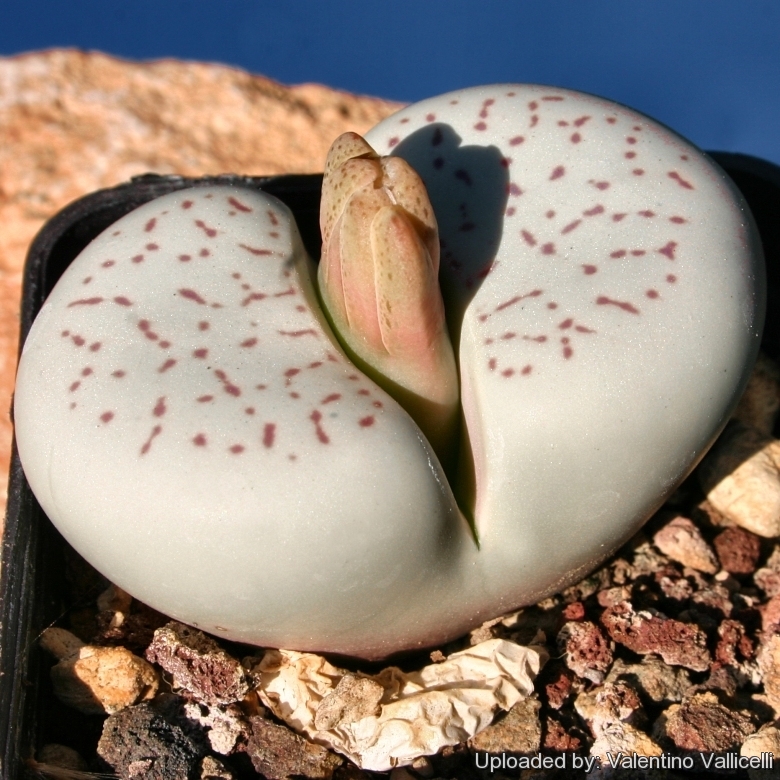
It is chalky white to clear pastel or greyish with irregular red or brownish markings and dots similar to that of a lithops. Its sunken growth form is understood as a development parallel to that in Lithops.
Origin and Habitat: Cape province, South Africa.
Habitat: The grow in fine sand and gravel among quartz stones, in a very dry area with prevalent rain in March. They both in colour and shape, resemble the stones and pebbles found in their natural habitat. The form and colour of the Dinteranthus have developed in order to allow them to live in the harsh conditions of their natural environment where they are able to stand extended periods of drought.
Synonyms:
- Dinteranthus vanzylii (L. Bolus) Schwantes
- Lithops vanzylii L. Bolus
ENGLISH: Living Stone, Split Stone Plant, Green Stone Plant, Stone Plant
ITALIAN (Italiano): Pianta Sasso
Description: Dinteranthus vanzyliiSN|14631]]SN|14631]] is an intriguing solitary or clumping plant with attractive bodies and flowers that is very similar to Lithops in shape and colours but with no apparent dormant period. Its sunken growth form is understood as a development parallel to that in Lithops. The other species of Dinteranthus grows above ground.
Stem: Stemless.
Body (paired leaves): 1,5-4 cm tall, more or less totally submerged in the ground rather like a species of Lithops, formed by two succulent leaves almost fully united to form a single, central-cleft, and sunken in the ground for most of the leaf length. The leaf pair forming a cone or a funnel with the leaf tips broad, flat, but sometime with a thin horny keel near the fissure. It is smooth, chalky white to clear paste or greyish (rarely yellowish green) with obscure brownish patterning and irregular red or dark brown dots which coalesce into distict lines similar to that of a Lithops. The intensity of marking varies greatly from plant to plant and comprises both completely chalky white plant without any marking and plant with brown markings and lines. The form with distinct brown markings and lines is also known as Dinteranthus vanzyliiSN|14631]]SN|14631]] var. lineatus.
Roots: Thickened tap-root.
Flower: Solitary, bright yellow to orange, 30 - 40 mm in diameter and bractless. Sepals 7-8, Stigmas 7-8.
Fruit: The seed pod is 8 - 10 locular
Remarks: The genus Dinteranthus is closely related to Lithops.
Notes: The strange appearance of Dinteranthus have made them very popular in succulent collections. They are similar in habit to Lithops but grows above ground (only D. vanzijlii is partly subterranean like Lithops with the top of each leaf tip exposed above soil). They are also called mimicry plants as they show a striking similarity to their background rocks and are difficult to detect when not in flower. The Dinteranthus have a pebbly look and are commonly known as pebble plants or living stones; each species is associated with one particular type of rock formation and occurs nowhere else. This camouflage also reduces the need for chemical defences against herbivores.
Bibliography: Major references and further lectures
1) James Cullen, Sabina G. Knees, H. Suzanne Cubey “The European Garden Flora Flowering Plants: A Manual for the Identification of Plants Cultivated in Europe, Both Out-of-Doors” Cambridge University Press, 11/ago/201
2) Heidrun E. K. Hartmann “Aizoaceae F – Z” Springer, 2002
3) Hermann Jacobsen, Vera Higgins (1946) “Description, Cultivation and Uses of Succulent Plants, Other Than Cacti” Abbey Garden Press.
4) Jacobsen "Handbook of succulent plants" (1960)
5) Barkhuizen "Succulents of southern Africa." (1981)
6) Court "Succulent flora of southern Africa" (1981)
7) Rolf Rawé “Succulents in the veld” Howard Timmins, 1968
8) Sean. Hogan “Flora” Timber Press, 2003
9) Japan Succulent Society. "Colour encyclopedia of succulents." (1981)
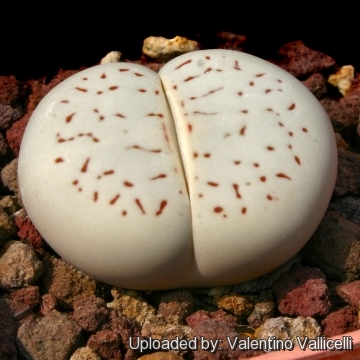
Dinteranthus vanzylii Photo by: Valentino Vallicelli
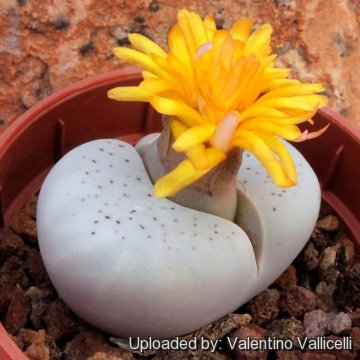
Dinteranthus vanzylii Photo by: Valentino Vallicelli
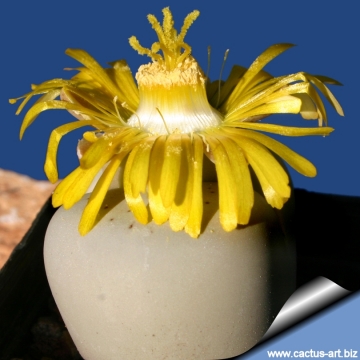
Dinteranthus vanzylii Photo by: Cactus Art
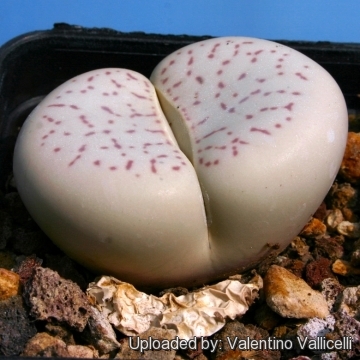
Dinteranthus vanzylii Photo by: Valentino Vallicelli
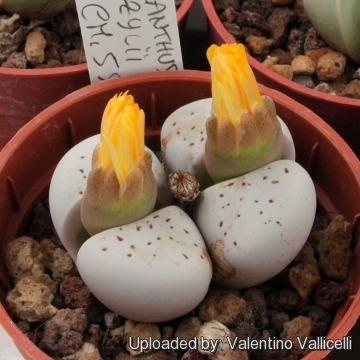
Dinteranthus vanzylii Photo by: Valentino Vallicelli

Dinteranthus vanzylii Photo by: Valentino Vallicelli
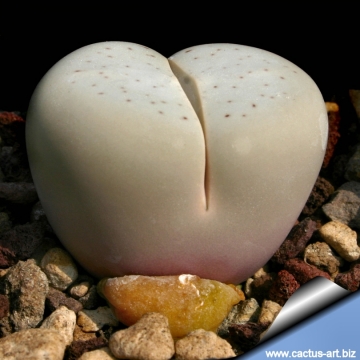
Dinteranthus vanzylii Photo by: Cactus Art
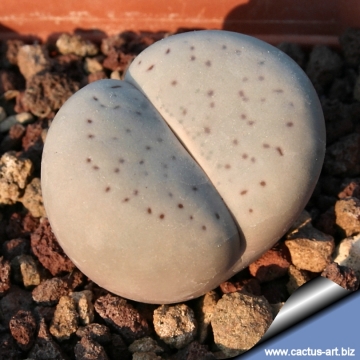
Dinteranthus vanzylii Photo by: Cactus Art
Cultivation and Propagation: Dinteranthus are summer growing species with dry rest period over winter but they do not shows an apparent dormant season like Lithops. Paying attention to the particular growing requirement of Dinteranthus is especially important. If you provide the Dinteranthus with the right conditions, they will reward you with their unique shape, size, colour and a proliferation of blooms in autumn. However, Dinteranthus are tricky plants that are very particular about their growing conditions and require the right maintenance in order to keep happy. But don't be afraid even the best growers have plants that mysteriously dry up, or leave during the night. While Dinteranthus are picky about their care, if you are patient and remember the basics, your efforts will be rewarded. Being small plants, a representative collection can be grown on a patio table, a sunny windowsill or a shelf in the greenhouse.
Growing rate: Slow growing for a mesemb.
Soil: Easy to grow they need a very open mineral, fast draining mix with little compost and a high degree of grit, coarse sand, small lava gravel or pebbles. They can grow outdoor in sunny, dry, rock crevices (protection against winter wet is required) They can also be cultivated in alpine house, in poor, drained soil.
Repotting: Keep them in small pots as solitary clumps or as colonies in large, shallow terracotta seed pans. Dinteranthus may stay in the same pot for many years. Plants grown in larger containers have frequently relatively poor flowers. Flowers might improve when the plants are given their own, small individual pots.
Exposition: Give them the maximum amount of light you are able to give them, but care should be taken about exposing them to the full blast of the sun rays in summer (The only exception to this is seedlings in their first year that enjoy a shades place). Such tiny plants can easily get scorched or broiled and their appearance spoiled (this may not matter in the wild, where the Dinteranthus have probably shrunk into the ground and becomes covered with sands).
Basic watering routine: Gives some water all year, more in Spring and again in autumn. Keep rather dry during coldest winter month and start watering regularly after the old leaves completely dry. (Usually late March or Early April) Water freely during the growing season, soak the compost fully but allow it to dry out between waterings. Nearly all problems occur as a result of overwatering and poor ventilation especially when weather conditions are dull and cool or very humid. If too much water is supplied the plants will grow out of character, bloat, split and rot. When in doubt DON'T WATER. Where the resting season is in the winter and central heating gives very dry air in the home, give a light top spray once a week to simulate the desert dew and prevent excessive dehydration. After flowering in the summer and extending through winter season the plant doesn’t need watering, but they will still be growing, the new bodies will be increasing in size extracting water from the outer succulent leaves, allowing them to shrivel away. In fact the plant in this time extracts water and nutrient stored in the outer succulent leaves, allowing them to dehydrate relocating the water to the rest of the plant and to the new leaves that form during this period until the old leaves are reduced to nothing more than "thin papery shells".
Fertilization: Feed them once during the growing season with a fertilizer specifically formulated for cactus and succulents (high potash fertilizer with a dilute low nitrogen), including all micro nutrients and trace elements diluted to ½ the strength recommended on the label. They thrive in poor soils and need a limited supplies of fertilizer to avoid the plants developing excess vegetation, which is easily attacked by fungal diseases. Some growers fertilize frequently, some hardly ever. However, for the highly succulent mesembs, (Lithops, Conophytums, etc.) fertilization is not really necessary.
Hardiness: Overwinter them preferably not below 5° C (But will take a light frost and are hardy down to -7° C for short periods if they are in dry soil). USDA zones 9A – 11.
Uses: Container, rock garden.
Pests and diseases: They are vulnerable to mealybugs and rarely scale.
Propagation: From seed (very small) or by dividing older clumps. The small seeds can be sown in pots of fine, well-drained sand, any time during the spring and summer months when temperatures are warm. Cover the seeds with a very fine layer of grit and water from below with a fungicide to prevent damping off. For the first 3-4 days cover the pots with a sheet of glass/clear perspex to keep the humidity levels high. Remove the glass and replace it with light shadecloth and mist once or twice a day for the next two weeks after which most seeds should have germinated. From then on mistings can be reduced to every second and then every third day as the little plants grow. Take the cuttings from a grown-up mother plant. Each cutting must contain one or more heads along with a fraction of root and permit them to dry out a couple of days, lay the cuttings on the soil and insert the stem end partially into the soil. Try to keep the cutting somewhat upright so that the roots are able to grow downward. It is relatively difficult to root Dinteranthus from cuttings and generally pointless as well, so quick are they from seed.
| Your Actions | |
|---|---|
| Back to Dinteranthus index | |
| Back to Aizoaceae index | |
 |
Back to Succulents Encyclopedia index |
Privacy stantement - Terms and conditions - How to cite - About us - Feedback - Donate




